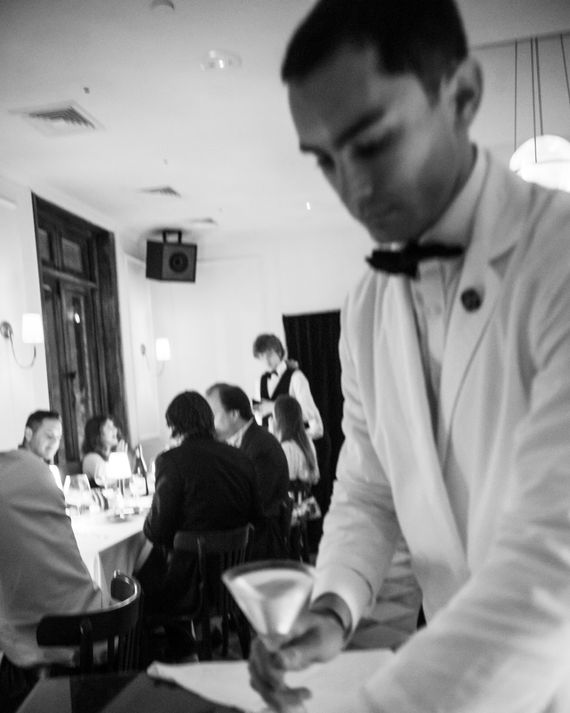
The upstairs dining room at Chateau Royale.
Photo: Landon Nordeman
The pendulum swings from cheap to swank and back again. I’ll leave it to the economists to tie the trend to jobs numbers or inflation data, the bread-and-butter equivalent of the hemline index (they’re shorter in booms, longer during busts). All I know is that the rough-and-ready comfort cuisine that dominated the crawl out of the pandemic a few years ago, a banquet-orgy of steaks, shrimp cocktails, and Caesar salads served in shouty canteens and new bistros manicured with the scabs of old ones, has given way to a new age of gloss. Fancy fancy? You’re in luck. Now ascendant: the swankstaurant.
Spots such as the minuscule clubhouse 4 Charles Prime Rib and Jon Neidich’s the Nines, with its burgundy velvet and caviar-topped baked potatoes, helped to establish the template for a proper swankstaurant. The past few months have seen a rush of them — from the gaslight glow of Chez Fifi uptown to the latest Chumley’s reboot, known as the Eighty Six, downtown — often coming from chefs and restaurateurs who had initially followed a more casual path. In rare cases, it’s possible to see that swing in a single space. At Chateau Royale, which opened this past summer from the owners of the West Village bistro Libertine, the restaurant is divided into two distinct levels, each with its own menu. In the ground-floor barroom, all dark cherry-wood and oxblood leather, the vibe is clubby, not quite cheap but down to earth. “Le Burger” balances out its bleu cheese with special sauce; a winky “chien chaud” is ground Wagyu with fermented kohlrabi slaw. I’ll take street-cart sauerkraut over its Greenmarket imitator any day, and I wouldn’t waste beef this pedigreed on a sausage grinder, but at $20, this Wagyu’s about as affordable as you’ll find it outside a sushi roll.
Upstairs, where the action is, Chateau Royale goes deluxe. The room is bright white and crown-molded; the windows here, unmuffled by downstairs’ thick curtains, open onto the street below. The banquettes (almost all of the seating involves banquettes) are swathed in velvet. Martinis tinkle your way (classic or dirty, gin or vodka) on a rolling bar cart piloted, during one of my dinners, by a smiling, white-jacketed man with a mini drink tattooed under his eye, a graduate, perhaps, of the School of Hard Shakes. Any such shakes have long been stilled: Here, the atmosphere is sumptuously genteel, and the only whiff of the demimonde comes from the tiny beggar’s purses — spoon-size satchels, $39 each, filled with crème fraîche and caviar — borrowed from the historic swankstaurant the Quilted Giraffe, where chef Brian Young used to cook.
Homage seems the order of the day. The menu is mostly French classics, mostly capably prepared: good, garlicky escargots; duck breast a l’orange, served in a style a little too reminiscent of chicken cutlet; au poivre’d steak. There are plenty of places, new and old, that do as much. It’s the vibes that rule the day here. On a recent evening, I overheard a manager rhapsodizing about a return to Paris-in-Manhattan grandeur, even if he himself “wasn’t alive for a lot of it — La Grenouille when it was La Grenouille.” Alas, the latter days of La Grenouille left something to be desired, but it could make you feel fabulous.
A more successful scrub-up is happening a few blocks away. Bartolo, a new Spanish restaurant from Ryan Bartlow, is a high-key counterpart to his scrappier Ernesto’s, tiny where Ernesto’s is spacious, Spanish to its Basque. Of the two, I find myself preferring the new spot. For architecture and décor, there’s no competition: Bartolo is made up of three interconnecting rooms in a cozy labyrinth, low-ceilinged and leathery but without the chummy claustrophobia of Chateau Royale’s barroom. Set on the parlor level of two adjoining storefronts, on warm nights Bartolo throws open the doors to the street, and with the view filtered through giant pots of blooming rosemary and iron gating, you could even mistake West 4th Street for a lost avenida of Madrid. A few Ernesto’s-esque tapas have made their way across town — gorgeous, eggplant-colored “anchoas” on grilled Spanish bread with cold slabs of butter cut thick enough to be cheese and the Bartlowian gildas that kick-started the gilda trend — but new-swank demands foie gras, port-wine reductions, and truffle shavings. Those are all right at home here.
Even still, I’ll confess that I preferred the more rustic, less elevated of Bartlow’s latest recipes. A huge platter of French fries (thick and garlicky, pale dominoes in the Madrileño style), shrimp, and fried eggs, cut together tableside by a server like a breakfast scramble until their marigold yolks soak the whole: I’m not sure I’ve had a simpler, more pleasurable dish in weeks. A plate of tripe, tender and springy like an animal chow fun, with a little plug of dark morcilla for good measure: Bartlow adapted the recipe from his time cooking at the three-star Akelarre in San Sebastián, but it’s the type of dish you’d be just as likely to find at the local tavern he lived above. It was the dressier dishes that more often let me down or would benefit from further tinkering. Cannelloni stuffed with long-braised beef, in said port-wine reduction, with said truffle and a liver sauce: heavy on heavy, unrelenting. Cuttlefish meunière with a bit too much bounce for me. But choose wisely and the room, the mood, and the booze will do the rest. Start, like the Spaniards do, with a “ginitonic” or a “vermut,” and proceed from there. The all-Spanish wine list includes some nice, smart surprises from lesser-known regions — Sanlúcar de Barrameda, Aragón, the Balearic islands — and Rioja for the Riojeros. And like any Spanish restaurant worth its sal here in historic Little Spain (once upon a time, this part of the West Village was home to a significant Galician population, and the restaurants catering to them), there’s a full complement of the fortified stuff. Take it from those eternal advocates of swank, the brothers Crane: Have a sherry.
Thank you for subscribing and supporting our journalism.
If you prefer to read in print, you can also find this article in the October 20, 2025, issue of
New York Magazine.
Want more stories like this one? Subscribe now
to support our journalism and get unlimited access to our coverage.
If you prefer to read in print, you can also find this article in the October 20, 2025, issue of
New York Magazine.

